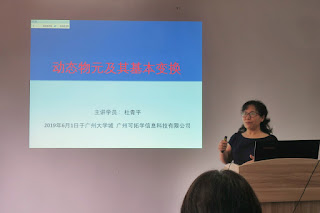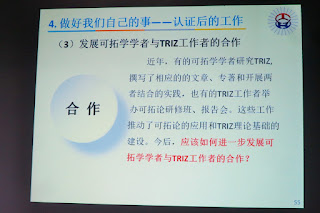The Examination
of the Extension Innovation Method Level 3 Certification (可拓創新方法三級水平認證) was organized by International
Academy of Extenis (國際可拓學研究院) and Guangzhou Extenics Information Technology Co., Ltd. (廣州可拓學信息科技有限公司) from 1st & 2nd
Jun 2019 in Guangzhou. This examination
separated into three parts: (1) Level 3 exercise paper prepared before the
examination, (2) 3.5hr open book examination and (3) case presentation.
In day one
(1st Jun 2019) at 2:00pm, Prof. Yang Chunyan (楊春燕) welcomed us for this
examination and briefed the rules.
Then we
started the examination. Prof. Yang is
one of invigilator.
Prof.
Xingsen Li (李興森) and Dr. Tang Long (湯龍) are also invigilators. We all focused on the examination questions.
In day
two (2nd Jun 2019) at 8:00am, Prof. Yang introduced the presentation
sequence and rules that 15 min for presentation and 5 min for Q&A. I summarized examiners comments (included
Prof. Cai Wen (蔡文), Prof. Yang Chunyan (楊春燕) and Prof. Li Xingsen (李興森) for further teaching skills improvement.
Before
the presentation, I took a photo with Prof. Cai Wen (蔡文), Prof. Yang Chunyan (楊春燕) and Prof. Li Xingsen (李興森).
I also
took a photo with Prof. Cai Wen (蔡文) and Ms. Liu Hui (劉惠) (Chairlady, Guangzhou Extenics
Information Technology Co., Ltd.) for memory.
The first speaker was Dr. Yang Xiaohui (楊小輝) and his topic was “Parametric Matter-element and its Application (參變量基元及其應用)”.
Dr. Yang
explained different examples and briefed the application.
Q&A:
Prof.
Cai Wen said the parameter could be time and space (時間和空間) and parametric matter-element
used to describe the change from quantitative to qualitative (從量變到質變).
The
second speaker was Prof. Ma Lixiu (馬立修) (山東理工大學) and his topic selected “Compound Element
and its Application (複合元及其應用)”.
He
introduced the 7 types of Compound Elements based on Matter-element,
Affair-element and Relation-element combination. However, Prof. Ma improved six more detailed
combination among them and got six more combination Compound Elements. Finally,
he said that Establishing Model is the fundamental of innovation.
Q&A:
Prof. Cai
Wen asked questions that Why introduce Compound Element and What is it, as well
as, using example to explain it.
The
third speaker was Ms. Ma Shumei (馬書美) and her topic named “Affair-element
Implication and its Application (事元蘊含系及其應用)”.
She used
cooking as example and explained Affair-element Implication from buying foods
to cook the food.
Q&A:
Prof. Li
Xingsen asked what to be done by using Affair-element Implication.
Prof. Yang
Chunyan said Implication included Existential Implication (存在蘊含) and Causal Implication (因果蘊含). Sometimes it needs to use n-dimension affair-element
for explanation.
Prof. Cai
Wen added the topic key part and supplementary part should be in order. He also
said the implication direction could be bi-direction or one-direction.
The
fourth speaker was Mr. Yang Xusheng (楊旭生) and his presentation was “Transformation
Operation and its Application (變換的運算及其應用)”.
Mr. Yang
briefed different cases under different transformation including (1)
Substitution transformation, (2) Increasing/decreasing transformation, (3)
Expansion/contraction transformation, (4) Decomposition transformation and (5)
Duplication transformation. Then he also mentioned basic operation of extension
transformation.
Q&A:
Prof. Li
Xingsen asked what type of transformation for adding catalysis for chemical
reaction. It should be PRODUCT transformation.
Prof. Yang
Chunyan suggested to use table for example would be better.
Prof.
Cai Wen said it started from the need-oriented and to explain the change.
The Prof.
Jiang Fan (江帆) (School of Mechanical and Electric Engineering, Guangzhou University)
was the fifth speaker and his topic was “Conductive Transformation and its
Application (傳導變換及其應用)”.
Prof.
Jiang said the implication relationship should be between active transformation
and conductive transformation. Many
people used conductive transformation for innovation and solving contradiction
problem. Lastly, he used mechanical part as example to explain the application
of conductive transformation.
Q&A:
Prof. Yang
Chunyan asked what relationship between Conductive Transformation and
Implication. It is causal relationship (因果關係).
I (Dr.
Lotto Lai) (HKSQ) was the sixth speaker and my presentation named “The Third Creative
Method and its Application (第三創造法及其應用)”.
Firstly,
I briefed the First Creative Method named “Create from nothing (无中生有)” which started from the
customer needs and the Second Creative Method named “Change in existing (有中求变)”, as well as, the Third
Creative Method named “Change from demerits (改缺成优)”.
Finally,
I demonstrated the third creative method step by step to create a need product
of leather shoes which could use for conference and tour together. Seven ideas were developed and three of them
selected through superiority evaluation method.
Q&A:
Prof. Yang
Chunyan corrected me that the characteristic of “Maintain” should be “Degree of
Maintenance” and the presentation of dependent function should be more precise
(e.g. k(x) =).
Prof. Li
Xingsen asked what direction to extend apart from these three types of creative
methods. I thought that it could be
started from advantage. However, it
could be also belong to the Second Creative Method.
The
seventh speaker was Ms. Lu Bihong (陸碧虹) and her topic was “Matter Conjugate Part
and its Application (物的共軛部及其應用)”.
After
explained the theory, Ms. Lu used “IP” as example to employ non-material and
material part to analysis their transformation.
Q&A:
Prof. Cai
Wen said Objective Nonmaterial Part (客觀虛部) started from business and Subjective
Nonmaterial Part (主觀虛部) was human related.
Prof.
Yang Chunyan asked the characteristic of positive and negative part.
The
eighth speaker was Mr. Zhong Bing (鍾兵) and his presentation named “Relation-element
Divergent Tree and its Application (關係元發散樹及其應用)”.
He used
compound board in engineering project as example to explain relation-element
and its divergent analysis.
Q&A:
Prof. Li
Xingsen asked what the systematic relation-element was.
Prof. Yang
Chunyan said the starting point was relation-element’s divergent tree and it
could be enhanced and enriched.
The
ninth speaker was Ms. Zhu Xi (朱纓) and her presentation was “Relationship between Matter-element
Correlation Net and Conductive Transformation” (物元相關網與傳導變換的關係)”.
She said the Correlation Net was foundation of Conductive Transformation.
Q&A:
Prof. Li
Xingsen asked to summarize the topic using one sentence. It is Extension Relationship (拓展關係)
Prof. Yang
Chunyan said Correlation Net was dynamic and Conductive Transformation was
based on it.
Mr. Liu
Hongzhong (劉宏中) was the tenth speaker and his topic entitled “Extension Model Establishing
Method (可拓模型的建立方法)”.
The
overall basic-element and its application were discussed. He used package as problem to explained the establishment
of extension model.
Q&A:
Prof. Li
Xingsen asked what method could ensure to raise out characteristics of
extension model.
Prof.
Yang Chunyan explained maximum mass was not characteristic but mass range was.
Prof.
Cai Wen gave a suggestion steps to present the topic below:
i)
What is the Extension Model?
ii)
Why need to establish it?
iii)
How to establish it?
iv)
What is the use?
v)
Pay attention to what is the problem.
vi)
Summary
The 11th
speaker was Mr. Li Xiaoping (李小平) and his topic was “The Second Creative Method and its Application (第二創造法及其應用)”. He used USB to explain the
second creative method.
Q&A:
Prof. Li
Xingsen said the second creative method started from basic-element.
Prof. Yang
Chunyan asked what relationship between Extension Innovation Four Step method
and the Second Creative Method.
Actually, they were the same.
Prof.
Cai Wen added the different between “Need” and “Demand”. Need (需要) is when no such product in the
market and Demand (需求) is from the existing product.
The 12th
speaker was Ms. Zhou Yan (周彥) and her topic was “Product Function’s Implication Analysis (產品功能的蘊含分析)”.
She
raised several examples and one of examples was projector that projected the
image but also generated heat.
Q&A:
Prof. Yang
Chunyan commented that the beginning part was too theoretical and difficult to
explain to public. It should be used function of product to explain implication.
The 13th
speaker was Ms. Du Qingping (杜青平) and her presentation named “Dynamic Matter-element and its Basic Transformation
(動態物元及其基本變換)”.
She used
cicada sound (蟬叫聲) as example to show the transformation under dynamic matter-element.
Q&A:
Prof. Yang
Chunyan said cicada is matter-element but cicada sound is affair-element. She used another example to explain dynamic
matter-element such as People cannot step twice into the same river (人不能兩次踏進同一條河流。). River could use dynamic
matter-element to describe.
Ms. Dong
Cuiling (董翠玲) was the last speaker and her presentation entitled “Superiority Evaluation
Method and its Application (優度評價法及其應用)”.
She briefed the purpose and criteria setting of superiority evaluation method.
Q&A:
Prof. Li
Xingsen asked in what situation no need to use superiority evaluation method.
Prof. Yang
Chunyan clarity the terms of PRODUCT and AND operation (積算法和與算法) should be “Maximum” and “Minimum”
operation (取最大和取最小).
After
the presentation and lunch break, we were waiting the examination result. The Extension Innovation Method level 3
training course team in 2017 took a group photo with Prof. Cai Wen (蔡文) for memory.
Prof.
Cai Wen (蔡文) gave a keynote to us and the topic entitled “Extension Achievement and
Recently Work”.
Firstly,
Prof. Cai Wen briefed the recognition of Extenics in academic field and its
positioning. Then he briefed the achievements.
Finally,
Prod. Cai Wen suggested to cooperate with TRIZ expert because TRIZ fundamental theory
is Extenics based on its research object – contradiction.
Lastly, Prof.
Li Xingsen (李興森) announced the Extension Innovation Method Level 3 list and took a
photo with Prof. Cai Wen individually.
I
received Level 3 certificate from Prof. Cai Wen. I studied Extenics since 2016 and achieve
level 1, level 2 and level 3 in 2016, 2017 and 2019, respectively.
At the end, we took a group photo for memory.
Reference:
Research
Institute of Extenics and Innovation Methods, GDUT (廣東工業大學可拓學與創新方法研究所) - http://extenics.gdut.edu.cn/info/1041/1302.htm
Previous Extenics Annual
Meeting activities (全國可拓學年會):
20160810
- Pre-Extenics Annual Meeting (全國第15屆可拓學年會) – Extenics Level 1 Exam - https://qualityalchemist.blogspot.hk/2016/08/pre-extenics-annual-meeting-15-extenics.html
20160811
- The 15th Annual Meeting of the Extenics (全國第15屆可拓學年會) – Day 1 - https://qualityalchemist.blogspot.hk/2016/08/the-15th-annual-meeting-of-extenics-15.html
20160812
- The 15th Annual Meeting of the Extenics (全國第15屆可拓學年會) – Day 2 - https://qualityalchemist.blogspot.hk/2016/08/the-15th-annual-meeting-of-extenics-15_12.html
第一期可拓创新方法水平认证会议通过认证人员名单 - http://extenics.gdut.edu.cn/info/1048/1674.htm
20180818:
The 16th Annual Meeting of the Extenics (全國第16屆可拓學年會) – Day 1 - https://qualityalchemist.blogspot.com/2018/08/the-16th-annual-meeting-of-extenics-16.html
20180819:
The 16th Annual Meeting of the Extenics (全國第16屆可拓學年會) – Day 2 - https://qualityalchemist.blogspot.com/2018/08/the-16th-annual-meeting-of-extenics-16_19.html
Trainer Course:
20170331:
Extension Innovation Method Trainer Course Level 1 - https://qualityalchemist.blogspot.hk/2017/03/extension-innovation-method-trainer.html
20170409:
Extension Innovation Method Trainer Course Level 2 - https://qualityalchemist.blogspot.hk/2017/04/extension-innovation-method-trainer.html
20170514:
Extension Innovation Method Trainer Course Level 3 - Part 1 - https://qualityalchemist.blogspot.hk/2017/05/extension-innovation-method-trainer.html
20170528:
Extension Innovation Method Trainer Course Level 3 - Part 2 - https://qualityalchemist.blogspot.hk/2017/05/extension-innovation-method-trainer_28.html










































沒有留言:
發佈留言